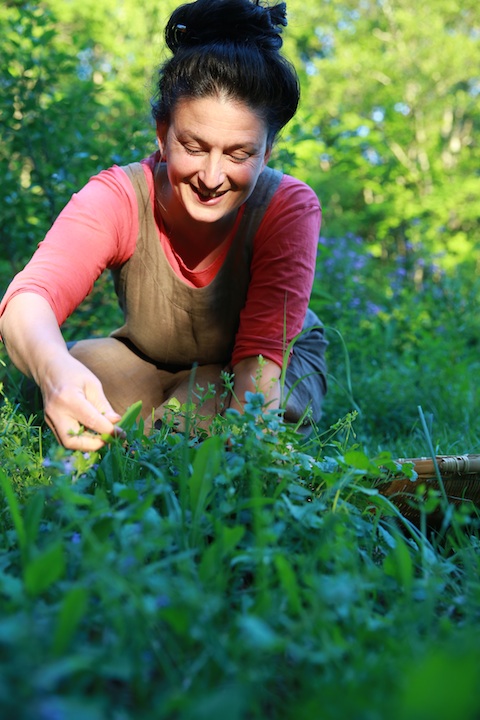Above: An Autumn Olive (Wildberry) Mojito. Photo courtesy of Marguerite Uhlmann-Bower. Make your own with the recipe at the bottom of this story.
Foraging for food that grows wild has long been a hobby for nature lovers out walking in the woods. But increasingly, more people are doing what their primitive ancestors did: picking up their spades and baskets and searching out edible flowers, leaves, roots, shoots, nuts and berries.
 Left: Dina Falconi, a Catskills forager.
Left: Dina Falconi, a Catskills forager.
Two upstate women—Dina Falconi and Marguerite Uhlmann-Bower—are leading the march into the forests and meadows. According to them, there’s plenty of free food out there for the picking; you just need to know what to look for.
Falconi, a Marbletown resident who grew up in New York City, has been steeped in the world of wild-plant identification, foraging and cooking for 30 years now. But growing up, she had no idea what was waiting out in the woods.
“As a city kid, I didn’t know you could find food growing wild or discover the tastiest berries out in a field,” she said.
Falconi’s recent book, Foraging & Feasting: A Field Guide and Wild Food Cookbook ($40, botanicalartspress.com), which includes botanical illustrations by Wendy Hollender, covers 50 common weeds that can be found throughout the world. In the first part of the book, she teaches readers how to forage; the second half is comprised of 100 recipes and their variations, such as Wild Shepherd or Cottage Pie (burdock root and grass-fed beef with a topping of mashed potatoes) and green pesto made with wild bergamot and garlic mustard.
Below: Cover art for Falconi's book, Foraging & Feasting. Used with permission.

Falconi is always on the hunt for new ingredients to incorporate. Her latest kick: pawpaws, a green-skinned tree fruit that used to grow wild in the region, but no longer does.
“I’ve planted a pawpaw grove on my land. I’m working to put the wild things back,” she said.
Uhlmann-Bower comes at foraging from a very different background. As a registered nurse now working part-time, she has a keen interest in the medicinal uses of plants. She’s been harvesting and picking her own herbs for more than 20 years, and began to see that foraged remedies could help where traditional medicine left off.
Right: Marguerite Uhlmann-Bower.
“I knew we needed to start with the basics—nutrition—to heal,” she said. “As a nurse, I couldn’t recommend herbs or alternative treatments, but I could recommend food. So I branched out from there.”
The Meredith resident studied to become an herbalist, and now teaches classes on how to identify, harvest and prepare food found in the wild. Her book Weeds, Leaves, Seeds & Shoots: Balance Your Budget – Steward the Land comes out in February 2015.
Though some are put off by the bitterness of many foraged, foods, Uhlmann-Bower maintains that it’s all for the good.
“I always say bitter is better, because it supports digestion and assimilation of nutrients," she said. "When we taste bitter flavor, our taste buds are stimulated to jump-start digestion.”
At this time of year, Uhlmann-Bower picks the browned, dried seeds of yellow dock—a member of the buckwheat family—and grinds them into powder. (She uses a flour mill, but a coffee grinder will also do the trick.) She then stores it for use as a gluten-free flour alternative in cookies, bread and desserts.
Both women are proponents of the autumn olive, an often-overlooked invasive berry that’s ripe now. According to Uhlmann-Bower, the bright red fruits are high in the antioxidant lycopene—and they’re great for juices, jams, pies or even mojitos. (Scroll down for Uhlmann-Bower’s recipe.)
For many people, foraging may seem like a foreign concept. But if you want to dip your toe in, both Falconi and Uhlmann-Bower are leading treks and teaching classes on foraging in the area over the next few weeks; check out the event listings below.
“Earth is bursting forth with things that are good and weedy,” said Falconi. “With foraging, you’re going out into nature yourself, feeling connected to your environment. It’s fun, free and good for you.”
Follow Falconi at botanicalartspress.com and Uhlmann-Bower at facebook.com/marguerite.uhlmannbower.
UPCOMING FORAGING EVENTS IN THE CATSKILLS
“Medicinal & Edible Plant Walk” with Falconi. Saturday, Oct. 11, 1 to 2 p.m. Free. Olive Free Library Association, West Shokan. olivefreelibrary.org.
“Medicinal & Edible Weeds and Mushrooms” talk with Uhlmann-Bower. Saturday, Nov. 22, 11 a.m. to 4 p.m. Donation suggested. Emma Treadwell Thacher Nature Center, Voorheesville. nysparks.com.
RECIPE: WILDBERRY MOJITO
By Marguerite Uhlmann-Bower
Serves 12
1 bunch fresh mint, trimmed (about 1 cup)
2 cups light rum
1 1/4 cups fresh lime juice
1/2 teaspoon nutmeg chips
1 cup autumn olive (other berries that can be used: Chinese lantern, rose hip, bar berry)
1 tsp cinnamon chips
Shake ingredients together in a lidded jar. Let sit for four days in the refrigerator. Strain. Add three cups of sparkling water and enjoy on ice or as is.














